
MAKE YOUR CATTLE STAND OUT
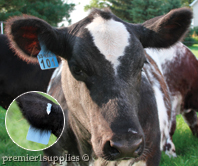
Z Tags
Use Z Tag ear tags to make your cattle easily identifiable to others in the show ring or at the production sale. The tags' large size and ability to be imprinted make them readable, even from a distance.
Use the tags for show and production cattle:
| • |
Identify sire and dam. |
| • |
Identify your farm. |
| • |
Large lot number.
|
FREE Customization on all of our ear tags!
Instead of punching a hole in the ear, the one-piece Z Tag makes a small incision and slides in (see photo inset above). No second piece is needed to hold the tag.
Applicator has a unique flip-out pin that allows tag to separate from applicator the instant the ear moves.
And the tags stay in! Folks who use them love them. Simple as that!
EXERCISE OUTSIDE OF THE RING
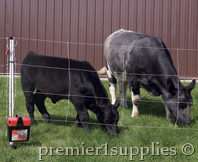
Need to exercise your show cattle?
Cattle QuikFence™ is an easy and fast alternative to creating an exercise pen with panels.
Cattle that are tied all day long can get a little antsy and stiff. Having even a small grassy area for them to work out the excess energy and any kinks is very beneficial. Stephanie (one of Premier's product consultants) uses Cattle QuikFence as evening turnout for an hour or so when she's traveling on the show circuit.
Helpful hints—
| • |
Use for trained/handled animals. (Remember you have to catch them, and livelier animals are harder to catch.) |
| • |
Animals should be familiar/comfortable with one another. A QuikFence pen is not meant for settling dominance issues. |
| • |
Do not leave the animals in overnight. Tie them or return them to the trailer.
|
| • |
Use QuikFence as a picture pen for halter broke cattle.
|
QuikFence is our most reliable semi-permanent electrified cattle fence. Has very visible (extra large) strands. Easy and fast to install—and equally simple to remove.
Consists of 4 “hot" interconnected wires. Bottom strand is suspended 1 ft above the soil. 48" tall. PVC line posts (3/4" diameter) with step-in foot are built into each roll.
Be sure to properly energize all fences with an energizer.
NEW PRODUCT
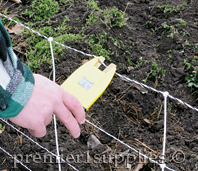
NEW!
Ez Digital Voltmeter
Self-grounding. No more hassles with a ground probe and its wires. Simply touch it to the fence and read the digital numbers. (4.3 = 4300 volts.)
View Premier's Fence Connectors and Accessories.
|
 |
 |
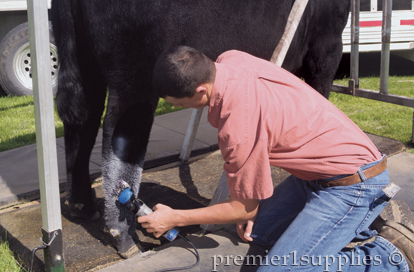
Are you ready for show season?
Premier's Clippers and Shears
Blocking—Use sheep heads (shears, shown in photo above). We know it may be confusing that sheep shearing machines are used on cattle. However, they are the best tools for this.
Equipment—There's only one best choice. A Phantom S comb and Spitfire cutter on a Premier 4000s machine.
Why? Because they excel at:
| • |
Precision hair removal. |
| • |
Quiet operation. |
| • |
Slicing cleanly through glued hair. |
Shaving—For removing hair from the head, brisket, tail or udder, use a Premier 4000c with either Fine or Medium blades .
Premier's Z Tags
can be custom imprinted with any numbers, words or logos you desire. Large, visible printing means tags can be read from a distance.
Cattle Rope Halter
for restraint of cattle at shows and at home. Halter is comfortable to the animal. Braided ends do not poke into the animals face/neck.
VIP ARTICLE
Cattle Clipping Basics
By Micky Burch
It’s no wonder people say fitting cattle is an art; the end result can be a masterpiece. But getting there takes time, practice and patience. For those just beginning, the variety of clippers and blades, and the know-how to create the end product can be overwhelming. It may be easier to understand by breaking things down into three parts: clippers and blades, clipping at home and clipping at the show.
Clippers & Blades There’s an exceptionally wide variety of clippers and blades on the market for use on livestock and there are several different types and styles that can be used for cattle. Further, different types of clippers and blades are used on different parts of the animal.
Any large clipper made for shearing sheep can be used to clip heads, Tucker Mittag, Mittag Show Cattle, Prescott, Iowa, says. “They work great because they provide a clean, even cut that is needed when clipping heads.” Oftentimes, a 24-tooth comb is a suitable fit for clipping heads.
Medium blending blades work very well for blending the neck or areas of the animal where the hair is left a little longer, Mittag says. “I also use this blade when clipping the hock, tail and rear quarter; it enhances these areas by giving an ultra smooth appearance,” he continues. The T-84 is a similar blade to the medium blending blade and is one that Mittag also uses to give the clipped area a very smooth look.
Clipping Prior to the Show
According to the steerplanet.com article “A Guide for Youth Beef Cattle Exhibitors,” clipping should only be done after the animal is thoroughly clean and dry. Clipping for a show should take place seven to 10 days ahead of time, with touch-up work a day or two prior to the show.
Before flipping the switch on the clippers, step back and evaluate the strengths and weaknesses of the animal. The idea of clipping is to enhance the strong points and try to disguise the weak points of the animal, the “Guide” says. Always remember that no two animals are clipped exactly alike.
Starting at the head and using the sheep clippers, clip the face from the poll to the nose and then from the face down the dewlap to the brisket. This method of clipping enhances the length of neck when blended with medium blending blades down to the brisket. To achieve a close, smooth job clipping the head, clip against the natural contour of the hair.
When clipping the top line and quarter, work to make the entire body of the animal look square. The hip hair is important to give the animal a level hip. Oftentimes, it’s left a little longer and blended into the hip and hindquarter, while the area close to the tail is trimmed shorter.
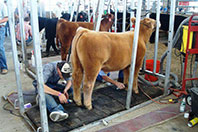
|
After fitting the legs, Tucker Mittag shapes them with clippers to make them look as straight as possible (photo by Mittag Design).
|
When clipping legs, it’s again important to make them look as square as possible without taking off too much hair—that hair will be needed later to shape, or “bone,” the legs and more hair will be clipped off during the fitting process at the show.
Make it a goal to blend in every part of the animal’s body without leaving hard lines and to make the animal look as natural as possible. Beginning fitters should use two hands: one for holding the clippers, and the other steadying and guiding them. Also, work one area of the animal at a time and evaluate it when you’re finished. Once satisfied with that area, move to the next section, and remember you can always go back and do touch-up work.
Clipping at the Show
Fitting, which oftentimes includes the use of adhesives, oils and sheens, should only be done on the day of the show, the “Guide” notes. Like clipping at home, it’s recommended to first wash and blow-dry the hair thoroughly; at a show, this can be done the night before as long as the animal is bedded in clean shavings or straw overnight so they stay clean. The next morning, if they’re not too dirty, all you have to do is blow the animal out and start preparing for the show.
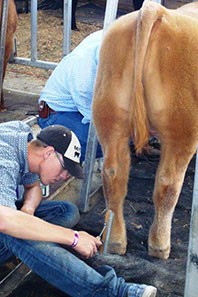
|
Tucker Mittag works to make the legs of the calf look as natural as possible by pulling the hair up and out (photo by Mittag Design).
|
Fitting partially consists of pulling the hair up on the legs, hindquarters and tail head. “Boning” legs is when the hair on the legs is pulled up with a scotch comb and sprayed with adhesive to make it hold — this fitting technique makes it look like the animal has more circumference of bone. Work to make the legs look as natural as possible by pulling the hair up and forward. After boning the legs, shape them with the clippers to make them look as straight as possible.
Grooming the body is usually simpler than the legs. Work the body hair by combing upward and forward, just like in the hair training process. Then spray an oil-based conditioner, like Final Bloom or Final Touch, on the hair coat and blow it into the hair. Now, you should be ready to hit the ring with a well-clipped and fitted animal.
While the very basics were covered here, remember it takes time, practice and patience to master the art of clipping cattle.
|
|